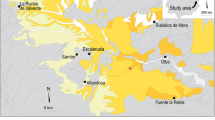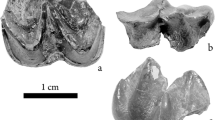Abstract
Ardiç-Mordoğan is a new fossil Mammal locality in the Karaburun Peninsula of Western Turkey. Among its fauna, which is described here, the carnivores are especially interesting, with the most complete specimens ever found ofPercrocuta miocenica and of a primitive species of hyaenid, of which a new subspecies is described,Protictitherium intermedium paralium. This fauna is strongly reminiscent of those of sever-al other Middle Miocene localities in this area, Çandir, Paşalar and Inönü in Turkey, and Prebreza in Serbia, and they must all belong to the same mammalian zone. Their ungulates attest an open environment which must have been widespread in the Turko-Balkanic area in Serravallian times.
Kurzfassung
Ardiç-Mordoğan ist ein neue Fundstelle auf der Karaburun-Halbinsel in der Westtürkei. Unter ihre Fauna, das ist hier beschreibt, sind die Carnivoren besonders interessant, mit die vollständigste bekannten Exemplaren vonPercrocuta miocenica und von eine primitiv Hyänen-Art, von welche ein neue Unterart,Protictitherium intermedium paralium, beschreibt ist. Die Fauna stark gleicht die von mehrere anderen Mittelmiozän Lagerstatten in derselben Gebiet: Çandir, Paşalar und Inönü in Türkei, und Prebreza in Serbien, und sie müssen sich allen zu dieselben Mammal-Zone gehören. Seinen Huftieren bezeugen ein offenes Umwelt, das bei der Türko-Balkanisch Gebiet in Serravallien Zeit verbreiten mussten.
Similar content being viewed by others
Literature
Arambourg, C. 1945.Anancus osiris, un mastodonte nouveau du Pliocène inférieur d’Egypte. — Bulletin de la Société Géologique de France (5)17: 301–310.
Azanza, B. &Morales, J. 1994.Tethytragus nov. gen. etGentrytragus nov. gen. Deux nouveaux Bovidés (Artiodactyla, Mammalia) du Miocène moyen. Relations phylogeńétiques des Bovidés anté-vallésiens. — Proceedings of the Koninklijke Nederlandse Akademie van Wetenschappen97 (3): 249–282.
Besenecker, H. 1973. Neogen und Quartär der Insel Chios (Ägäis). — PhD. Freie Universität Berlin184: 59.
Blainville, H.M.D.de 1841. Ostéographie et description iconographique des Mammifères récents et fossiles (Carnivores). 2, Baillière, Paris.
Bonis, L. de;Koufos, G.D. &Sen, S. 1997. A Giraffid from the Middle Miocene of the island of Chios, Greece. — Palaeontology40 (1): 121–133.
Bonis, L. de;Koufos, G.D. &Sen, S. 1998. Ruminants (Bovidae and Tragulidae) from the middle Miocene (MN5) of the island of Chios, Aegean sea (Greece). — Neues Jahrbuch für Geologie und Paläontologie, Abhandlungen210 (3): 399–420.
Colbert, E.H. 1939. A skull and mandible ofGiraffokeryx punjabiensis Pilgrim. — American Museum Novitates632: 1–14.
Crusafont-Pairo, M. &Aguirre, E. 1971. A new species ofPercrocuta from the Middle Miocene of Kenya. — Abhandlungen des Hessischen Landesamtes für Bodenforschung60: 51–58.
Deperet, C. 1892. La faune de Mammifères miocènes de la Grive-Saint-Alban (Isère) et de quelques autres localités du bassin du Rhône. — Archives du Muséum d’Histoire Naturelle de Lyon5 (2): 1–93.
Erdogan, B.;Altiner, D.;Güngör, T. &Özer, S. 1990. Stratigraphy of Karaburun Peninsula. — Bulletin of Mineral Research and Exploration111: 1–20.
Fortelius, M. &Bernor, R. 1990. A provisional systematic as-sessment of the Miocene Suoidea from Pasalar, Turkey. — Journal of Human Evolution19 (4–5): 509–528.
Fortelius, M.;Werdelin, L.;Andrews, P.;Bernor, R.L.;Gentry, A.;Humphrey, L.;Mittmann H.-W. &Viranta, S. 1996. Provinciality, diversity, turnover, and paleoecology in land mammal faunas of the Later Miocene of western Eura-sia. — In:Bernor, R.;Fahlbusch, V. &Mittmann, H.-W., eds., The Evolution of Western Eurasian Neogene Mammal Faunas: 414–448 (Columbia University Press).
Gabunia, L.K. 1973. Fossile Wirbeltiere in der Fauna von Bjelometschesk. — Akademie Nauk Grusinsk. SSR: 1–138 (in Russian).
Gaziry, A. 1976. Jungtertiäre Mastodonten aus Anatolien (Türkei). — Geologisches Jahrbuch (B)22: 1–143.
Geraads, D.;Gülec, E. &Sarac, G. 1995. Middle Miocene Ruminants from Inönü, Central Turkey. — Neues Jahrbuch für Geologie und Paläontologie, Monatshefte1995 (8): 462–474.
Geraads, D. in press. Ruminants, other than Giraffidae. — In:Güleç, E.;Begun, D. &Geraads, D., eds., Geology and Vertebrate Paleontology of the Middle Miocene Hominoid Locality Candir (Central Anatolia, Turkey). — Courier Forschungsinstitut Senckenberg.
Geraads, D. &Aslan, F. in press. Giraffidae. — In:Güleç, E.;Begun, D. &Geraads, D., eds., Geology and Vertebrate Paleontology of the Middle Miocene Hominoid Locality Candir (Central Anatolia, Turkey). — Courier Forschungsinstitut Senckenberg.
Geraads, D. &Güleç, E. in press. The middle Miocene hominoid site of Candir, Turkey: Proboscidea. — In:Güleç, E.;Begun, D. &Geraads, D., eds., Geology and Vertebrate Paleontology of the Middle Miocene Hominoid Locality Çandir (Central Anatolia, Turkey). — Courier Forschungsinstitut Senckenberg.
Geraads, D.;Begun, D. &Güleç, E. in press. The middle Miocene hominoid site of Çandir,Turkey: general paleoecological conclusions from the mammalian fauna. — In:Güleç, E.;Begun, D. &Geraads, D., eds., Geology and Vertebrate Paleontology of the Middle Miocene Hominoid Locality Çandir (Central Anatolia, Turkey). — Courier Forschungsinstitut Senckenberg.
Heissig, K. 1974. Neue Elasmotheriini (Rhinocerotidae, Mammalia) aus dem Obermiozän Anatoliens. — Mitteilungen der Bayerischen Staatsammlung für Paläontologie und Historische Geologie14: 21–35.
Helbing, H. 1930. Zur Kenntniss der miocänen„Mustela“ zibethoides Blainville. — Eclogae Geologiae Helvetiae23 (2): 637–644.
Howell, F.C. &Petter, G. 1985. Comparative observations on some middle and upper Miocene hyaenids. Genera:Percrocuta Kretzoi,Allohyaena Kretzoi,Adcrocuta Kretzoi (Mammalia, Carnivora, Hyaenidae). — Géobios18 (4): 419–476.
Kaya, O. 1981. Miocene reference section for the coastal parts of West Anatolia. — Newsletters on Stratigraphy10 (3): 164–191.
Kaya, T.;Tuna, V. &Geraads, D. 2001. A new late Orleanian/early Astaracian Mammalian fauna from Kultak (Milas-Muğla), southwestern Turkey. — Géobios34 (6): 673–680.
Kretzoi, M. 1938. Die Raubtiere von Gombaszög nebst einer Übersicht der Gesamtfauna. — Annales Musei Nationalis Hungarici31: 89–157.
Köhler, M. 1987. Boviden des Türkischen Miozäns (Känozoikum und Braunkohlen der Türkei, 28). — Paleontologia i Evoluciö21: 133–247.
Lartet, E. 1851. Notice sur la colline de Sansan. — Annuaire du Département du Gers: 1–45.
Meyer, H. von 1846. Mitteilungen an Prof. Bronn gerichtet. — Neues Jahrbuch für Mineralogie, Geologie und Paläontologie1846: 462–476.
Nagel, D. in press. Carnivora from the middle Miocene Hominoid locality of Çandir (Turkey). — In:Güleç, E.:Begun, D. &Geraads, D., eds., Geology and Vertebrate Paleontology of the Middle Miocene Hominoid Locality Çandir (Central Anatolia, Turkey). — Courier Forschungsinstitut Senckenberg.
Ozansoy, F. 1965. Etüde des gisements continentaux et des Mammifères du Cénozoïque de Turquie. — Mémoires de la Société Géologique de France, N.S.44 (1): 1–92.
Pavlovic, M. 1969. Miocene Mammals from the Toplitska valley. — Annales Géologiques de la Péninsule Balkanique34: 269–394 (in Serbian, with German abstract).
Pavlovic, M. &Thenius, E. 1965. Eine neue Hyäne (Carnivora, Mammalia) aus dem Miozän Jugoslawiens und ihre phylogenetische Stellung. — Anzeiger der Österreichischen Akademie der Wissenschaften, Mathemathisch-naturwissenschaftliche Klasse102 (2): 177–185.
Pickford, M.;Gabunia, L.;Mein, P.;Murales, J. &Azanza, B. 2000. The Middle Miocene Mammalian site of Belometchetskaya, North Caucasus: an important biostratigraphic link between Europe and China. — Géobios33 (2): 257–267.
Pilgrim, G.E. 1910. Notices of new mammalian genera and species from the Tertiaries of India. — Records of the Geological Survey of India40: 63–71.
Pilgrim, G.E. 1913. The correlation of the Siwaliks with the mammal horizons of Europe. — Records of the Geological Survey of India43: 264–326.
Pilgrim, G.E. 1934. Two species of sheep-like Antelope from the Miocene of Mongolia. — American Museum Novitates716: 1–29.
Robertson, A.H.F. &Pickett, E.A. 2000. Palaeozoic-Early Tertiary Tethyan evolution of mélanges, rift and passive margin units in the Karaburun Peninsula (western Turkey) and Chios Island (Creece). — In:Bozkurt, E.;Winchester, J.A. &Piper, J.D.A., eds., Tectonics and Magmatism in Turkey and the surrounding area. — Geological Society, Special Publication173: 43–82.
Schmidt-Kittler, N. 1976. Raubtiere aus dem Jungtertiär Kleinasiens. — Palaeontographica (A)155: 1–131.
Sokolov, J.J. 1949. On the remains of Cavicornia (Bovidae, Mammalia) from the middle Miocene of the north Caucasus. — Dokladi Akademie Nauk SSSR67: 1101–1104.
Steininger, F.F. 1999. Chronostratigraphy, Geochronology and biochronology of the Miocene “European land mega zones (ELMMZ)” and the Miocene “mammal-zones (MN Zones)”. — In:Rössner, G.E. &Heissig, K., eds., The Miocene land mammals of Europe: 9–24, München (F. Pfeil).
Tassy, P. 1983. Les Elephantoidea Miocènes du Plateau du Potwar, Groupe de Siwalik, Pakistan. 2.Choerolophodon etGomphotheres. — Annales de Paléontologie69 (3): 235–297.
Tassy, P. 1986. Nouveaux Elephantoidea (Mammalia) dans le Miocène du Kenya. — Cahiers de Paléontologie, CNRS. — 135 p., Paris.
Tassy, P. 1987. A hypothesis on the homology of Proboscidean tusks based on paleontological data. — American Museum Novitates2895: 1–15.
Van der Made, J. 1996. Listriodontinae (Suidae, Mammalia), their evolution, systematics and distribution in time and space. — Contributions to Tertiary and Quaternary Geology33(1–4): 1–254.
Van der Made, J. in press. Suoidea (pigs) from the Miocene hominoid locality Çandir in Turkey. — In:Güleç, E.;Begun, D. &Geraads, D., eds., Geology and Vertebrate Paleontology of the Middle Miocene Hominoid Locality Candir (Central Anatolia, Turkey). — Courier Forschungsinstitut Senckenberg.
Viranta, S. &Andrews, P. 1995. Carnivore guild structure in the Paşalar Miocene fauna. — Journal of Human Evolution28 (4): 359–372.
Werdelin, L. &Solounias, N. 1991. The Hyaenidae: taxonomy, systematics and evolution. — Fossils and Strata30: 1–104.
Author information
Authors and Affiliations
Corresponding author
Additional information
An erratum to this article is available at http://dx.doi.org/10.1007/BF03009142.
Rights and permissions
About this article
Cite this article
Kaya, T., Geraads, D. & Tuna, V. A new Middle Miocene mammalian fauna from Mordoğan (Western Turkey). Paläontol Z 77, 293–302 (2003). https://doi.org/10.1007/BF03006943
Received:
Accepted:
Issue Date:
DOI: https://doi.org/10.1007/BF03006943




